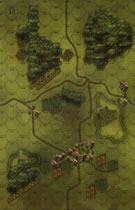|
Married, with Children Last Days of May #47 |
||
|---|---|---|
| (Defender) Germany | vs | France (Attacker) |
| Formations Involved | ||
|---|---|---|
| France |  |
22e Régiment d'Infanterie Coloniale |
| France |  |
4e Division Cuirassée de Réserve |
| Germany |  |
57th Infantry Division |

|
| Overall Rating, 0 votes |
|---|
|
0
|
| Scenario Rank: --- of 968 |
| Parent Game | Last Days of May |
|---|---|
| Historicity | Historical |
| Date | 1940-05-28 |
| Start Time | 17:00 |
| Turn Count | 16 |
| Visibility | Day & Night |
| Counters | 67 |
| Net Morale | 0 |
| Net Initiative | 2 |
| Maps | 1: 31 |
| Layout Dimensions | 43 x 28 cm 17 x 11 in |
| Play Bounty | 216 |
| AAR Bounty | 223 |
| Total Plays | 0 |
| Total AARs | 0 |
| Battle Types |
|---|
| Exit the Battle Area |
| Inflict Enemy Casualties |
| Urban Assault |
| Conditions |
|---|
| Hidden Units |
| Off-board Artillery |
| Reinforcements |
| Scenario Requirements & Playability | |
|---|---|
| Fall of France 1 | Maps + Counters |
| Last Days of May | Base Game |
| Introduction |
|---|
|
In the center of DeGaulle’s attack, the 44th Tank Battalion would advance along the Limeux-Limercourt-Huchenneville axis, supported by a regiment attached to 4th DCR from the 5th Colonial Infantry Division. With the tanks delayed by muddy roads, the 22nd Colonial Infantry Regiment advanced into the face of enemy machine guns. Though part of La Coloniale, the French overseas army, only the cadre came from that branch with the rank and file constituted by reservists from across southern France – married men over age 30 with children, subject to recall only in wartime. |
| Conclusion |
|---|
|
“The 22nd RIC,” DeGaulle declared, “is the first French regiment which, since the war began, has won a German position in a fierce struggle and held it in the face of all counter-attacks.” Though stirring, DeGaulle’s words were only partially true. The infantry advanced without the tanks and took about 500 meters before German fire pinned them down. The tanks finally arrived at 1800, by which time Limeux was burning. Fire from the tanks and the colonials’ machine guns shot a German reinforcement column to pieces, and the French advanced towards Caumont, where the main German resistance point was the castle. The Germans had placed numerous anti-tank guns around the castle, but the colonials stormed in and killed most of the defenders. The German infantry fought fiercely before they broke and fled, abandoning weapons, food and equipment. In four hours, the French had gained four kilometers, taking all of their objectives by nightfall. And then DeGaulle ordered a retreat, throwing away the reservists’ success and the opportunity to press their advantage. |

 LDoM006
LDoM006 



























